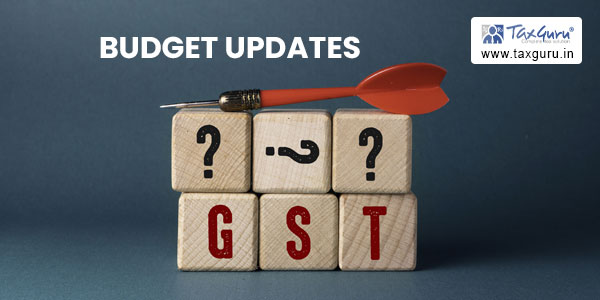CA. RAJAT MOHAN
B.Com(H), A.C.A., D.I.S.A.
1. Introduction
In Budget Speech 2010 -2011 Pranab Mukherjee, Minister of Finance showed his keenness to introduce GST from 1st April 2011.
1st April 2011 is not a distant day. We as professionals not even has clear 365 days before this Herculean act comes into being.
It is being said that the procedure of returns, etc. would be a lot easier and quicker. I bring before you all the procedure aspects of this future of enactment.
2. GST Return
It would be mandatory for registered dealers to furnish return electronically in Form No. GST-I, which would be a combined monthly payment and return form for all intra-state and inter-state transactions. Periodicity of furnishing this return would be monthly.
Electronic filing of any other returns could also be mandatory and forms could be common for both CGST and SGST compliance.
Taxpayers opting for the compounded levy may be required to pay their taxes and file their returns on a quarterly basis.
SAMPLE RETURN
3. Payment of GST
All registered dealers across the country shall pay the sum due as CGST and SGST to the credit of the Central Government and all other States within 1 week from the end of the month to which the sale transactions relate. It would be mandatory for all registered dealers to make the payment by electronically furnishing Form No. GST-I, which would be a combined monthly payment and return form for all transactions.
Registered dealer would be required to make a single payment of the aggregate of all sums due to the Centre and to all other States. Even though he would have collected tax in the Origin State (like Delhi) for inter-state transactions with buyers in a number of destination States (like Maharashtra, Haryana, and Karnataka etc.). He directly remits the tax so collected to all the destination states through a single payment made along by electronically furnishing Form No. GST-I.
Procedure E-payment
The procedure for making payment of in Form No. GST-I shall be as under:-
(a) Seller will open Nodal Bank website or approach GST facilitation centre (say www.gst.gov.in) to submit Form No. GST-I. The Nodal Bank would only serve as the payment gateway to facilitate payment in any bank in which the dealer has an internet banking account.
(b) Seller will enter his basic details such as his BIN, Financial year, Name, Phone and email on Form No. GST-I.
(c) Seller shall enter the details of such individual invoices.
(d) The total of GST will be computed automatically and Seller can enter additional details for Interest, penalty or other amounts as applicable. The complete total will be calculated automatically.
(e) Seller will have to submit this information for payment by direct debit to his bank account, as is the procedure for any e-payment.
(f) Nodal Bank will transmit ONLY the total GST amount information, along with details of the Seller as per the challan information, to the bank for debit to the Seller’s bank account. Nodal Bank will NOT transmit any information about the Invoices to the bank.
(g) The Internet banking website of the bank will be opened automatically and the Seller will have to enter his login and password relevant for internet banking to access his bank account. Then the total GST amount as per the challan will be debited to his account and credited to Government account by the bank. The bank will confirm to Nodal Bank details of successful deposit of GST amount to Government account.
(h) After receipt of the confirmation from the bank regarding the payment made by seller, Nodal Bank would generate Form No. GST-I, which can be printed out by the Seller for his recording purpose.
4. Invoice
The law should require a supplier making a taxable supply to another taxable person to provide an invoice with that supply or the payment for it. This requirement would be enforceable by some penalty. The GST invoice should be standardized across all states so as to contain a minimum of information about the supply being invoiced.
The seller would issue an invoice to the buyer indicating the details of the transaction which are as follows:
a) Invoice number,
b) Date of the invoice,
c) Business identification number of the registered purchaser or seller
d) Date of the transaction
e) Amount of GST
f) Consideration
SAMPLE FORMAT
| AIRCELL Private Limited
INVOICE |
|
| Address of service recipient
BIN no. of recipient: |
Mobile no. |
| Invoice no. | |
| Bill Period: dd/mm/yyyy – dd/mm/yyyy | |
| BIN no. of AIRCELL | |
| Current Charges | |
| Particulars | Amount (Rs.) |
| Monthly Rent | xxx |
| Add: Price Plan | Xxx |
| Add: Airtime Charges | Xxx |
| Add: DOT Local | Xxx |
| Add: Late Fees | Xxx |
| Total Current Charges | Xxx |
| GST @ 12% on current charges | Xxx |
| This Month’s Charges | Xxx |
| Add: Previous balance | xxx |
| Less: Payments | Xxx |
| Amount payable | XXXX |
5. Registration with GST authority
All persons with annual aggregate turnover of goods and services exceeding Rs.10 Lacs should be required to register and obtain a GST registration number. Persons with lower turnover would be given an option to register. The GST registration number could be a 12 digit alpha numeric number. The first ten digits should be the alpha-numeric PAN followed by two more digits indicating the state code. There will be a single GST registration number for all branches in a State. Therefore, a dealer having branches across States will have as many GST registration numbers each of respective states in which he operates.
Since the number is PAN based, it is not necessary to have any pre-registration verification. However, the states may, if necessary, undertake post-registration verification to eliminate any potential abuse. It is also mandatory for all registered dealers to obtain an e-mail ID and also open one internet banking account with any bank.
6. Miscellaneous
6.(i). Check posts
The function of all state border check posts should be reduced to checking of illegal or prohibited trade by setting up large scanners for trucks to pass through without any need for physical verification. The cost of the scanners should be borne by the Central Government. All check-posts should be jointly manned by both States so as to reduce the number of check-posts and enhance efficiency in the movement of goods.
We could feel that future of intra state check posts would be corruption free and tech savvy, though this may take time and money but this is the need of hour.
6.(ii). Computerization
The Central Government shall establish a common IT infrastructure which will serve the need of both CGST and SGST. Central Government will be responsible for establishing a TIN keeping in view the information requirement of CBEC and the State tax administration. The TIN will be shared between the Centre and the States.
6.(iii). Administration
The proposed GST will be a dual levy. Therefore, concern has been expressed by many sectors of the economy i.e. industrialists, professionals and government officials regarding administrative structure for implementing the CGST and the SGST consistent with the autonomy of the different levels of Government. Therefore, recommended tax administration structure is as explained below.
The Central Board of Excise & Customs shall be responsible for implementing the CGST and the State Tax administration will be separately responsible for implementing the SGST. The jurisdiction between the CBEC and the State Administration may be divided between the two in such a manner that the interface of the taxpayer is confined to one tax administration only. The basis of division could be turnover or any other criteria mutually decided by CBEC and State Tax Administration.
The various tax administrative functions such as assessment, enforcement, scrutiny and audit should be undertaken by the CBEC in respect of the CGST and by the State tax administration in respect of the SGST.
6.(iv). Audit
CBEC and the State tax administration can design an audit strategy. However, they must ensure that the same taxpayer is not subject to simultaneous audit under CGST and SGST.
6.(v). Others
(a) Each taxpayer should be allotted a PAN based taxpayer identification number.
(b) The unit of taxation for the purpose of GST should be persons as defined under the Income Tax Act.
(c) For the purpose of CGST, all production units/branches of a person located anywhere in the country will be treated as a single taxable entity eligible for CGST input credit across units/branches.
(d) For the purpose of SGST, all production units/branches of a person located anywhere within the State will be treated as a single taxable entity eligible for SGST input credit across units/branches in that State.
(e) There should be a common appellate authority and Authority for Advance Ruling will also be common.
(f) All procedures under CGST and SGST should be uniform.
MOHAN AGGARWAL & ASSOCIATES
Chartered Accountants
F-31 D.B. Gupta Market, Karol Bagh, New Delhi
Office Phone: 011-23672609 / 23535809
Mobile: 9910044223
Web url: www.delhicamohan.com






















pl give me detail of source of this information